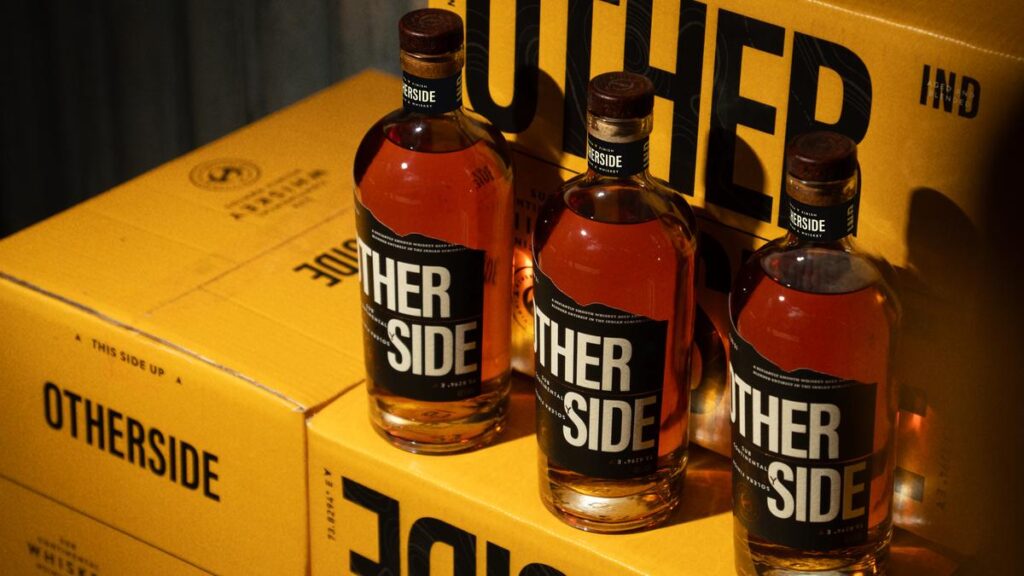In 2020, when Stranger & Sons gin took home a Gold Outstanding medal at the annual International Wine & Spirit Competition (IWSC) in London, it was clear that Indian spirits were no longer on the sidelines. The so-called ‘gin revolution’ had arrived, and with it, a shift in how Indian spirits were perceived both at home and abroad.
‘Premiumisation’ became the buzzword, and suddenly, consumers were not just drinking — they were exploring, curating, and investing in their bottles. Now, a few years down the line, another shift is underway. And this time, it is whiskey’s turn.
Third Eye Distillery, the name behind Stranger & Sons, is now turning its attention to the behemoth that is India’s whiskey market with the launch of Otherside Subcontinental Whiskey — a homegrown blend that embraces India’s tropical extremes.
The whiskey is blended in ex-bourbon barrels using a Solera process
| Photo Credit:
Special Arrangement
Whiskey in India is a serious business. The country is the largest consumer of the spirit in the world, with a market that skews heavily towards Scotch and Scotch-inspired blends. According to Statista, in 2025, India’s whisky market is projected to generate approximately US$17.5 billion (₹1.5155 trillion) in revenue from at-home consumption, with an expected volume of 3.2 billion litres.
But as Rahul Mehra, CEO and co-founder of Third Eye Distillery, points out, there is a gap in the market — one that mirrors the gin scene from a few years ago. “The whiskey space in India is still dominated by Scotch or products that mimic Scotch. There hasn’t been a true embrace of what India, with its unique climate and geography, can bring to the table.”
Past and present
India’s whiskey story has long been tied to imported Scotch, a colonial hangover that still influences drinking habits today. The early decades post-independence saw the rise of mass-produced, molasses-based whiskeys — technically rums — masquerading as whiskey. The premium whiskey space remained largely untouched by Indian players, save for a few outliers like Amrut, Paul John, and Rampur, which put Indian single malts on the global map.
But the blended whiskey space, the everyday pour, remained largely uninspired. Consumers either reached for familiar international names or settled for local blends that played it safe. Otherside, however, is looking to change that.
Born in the tropics
Aged across India’s diverse climates and distilled in Goa, Otherside embraces the heat, monsoons, and shifting seasons that influence maturation in ways colder climates never could. “Scotland set the rules, but they don’t apply here,” Rahul explains. “A whiskey that takes 12 years to age there develops in just four to five years in India. The interaction with the wood, the climate-driven maturation — this is something uniquely Indian, and we should own it.”
Unlike Scotch, which adheres to strict regional and production rules, Otherside is defining its own space. It is a blended Indian whiskey aged entirely in India, finished in charred ex-bourbon barrels using a Solera process that layers depth and complexity.
Otherside is, in short, complex yet approachable
| Photo Credit:
Special Arrangement
“We’re not trying to make an ‘Indian Scotch.’ We’re making an Indian whiskey that truly represents where it’s from.”
So, what does Otherside actually taste like? In short: Complex yet approachable. “There’s an unmistakable sense of land and sea breeze, the kind of air you smell when you’re on a beach,” Rahul says. “A little hint of smoke, a depth that makes it feel like a complete whiskey.”
This balance, he notes, comes from the malts used, the ageing process, and the environment in which it matures. The result? A whiskey suited for everyday drinking, occasional sipping, and even cocktails. “We drink like this, so we’re putting out a whiskey that fits into how we actually drink.”
Changing perceptions, one sip at a time
While Indian single malts have gained recognition, blended Indian whiskeys still face perception challenges. Premium Indian blends are often dismissed in favour of Scotch, despite India’s massive consumption numbers. But consumer habits are evolving.
With the rise of homegrown craft spirits, there is a growing appetite for authenticity — products that reflect their provenance rather than imitate foreign benchmarks. Much like how American whiskey carved its own path instead of mimicking Scotch, India’s whiskey industry is at a crossroads. The question is no longer whether India can make great whiskey, but whether it can create an identity of its own.
With Otherside, Third Eye Distillery is betting on the latter. “We were bored of what was happening in India,” Rahul admits. “The experiential side of drinking was missing. People were being sold whiskey based on where it was from, not what it actually tasted like. That didn’t excite us as consumers, so we decided to change that.”
Looking ahead
Otherside launches first in Goa and Mumbai, followed by Haryana and Karnataka. The idea also is to shift the narrative. “Not all whiskey drinkers play chess,” Rahul jokes, referencing the old-school imagery that often surrounds the drink. “It’s time to take whiskey outdoors, to break free from stiff traditions and just have fun with it.”
The challenge now is to get ‘liquid to lips’ — to let consumers experience something different and see if it resonates. If the gin revolution was anything to go by, Indian whiskey might just be the next big thing.
Published – February 21, 2025 03:02 pm IST
Source:https://www.thehindu.com/life-and-style/tired-of-the-same-old-scotch-there-is-a-new-pour-for-you/article69246426.ece

